What pops into your mind when you think of Greenland?
Green and fertile?
Wrong !
It’s almost entirely covered by the Greenland Ice Sheet / Ice Cap.
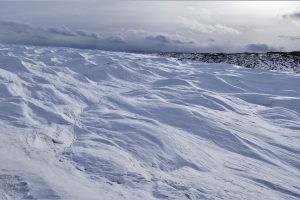

Colorful villages perched on seaside cliffs with mountain backdrops?
Yes !
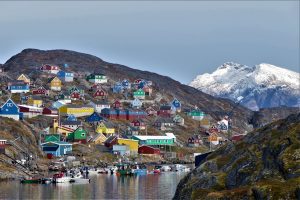
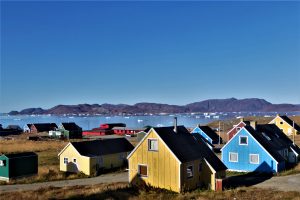
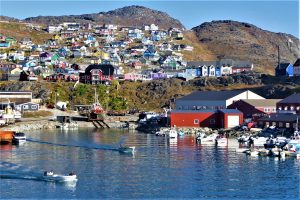
It’s accurate, but it tells only a part of the story of this fascinating country
Overview of Greenland
Greenland is huge – it’s the largest island in the world (Australia is a continent).
It is 10% larger than Mexico and 25% larger than Alaska.
It stretches for 1,660 miles north to south – the distance from New York to Denver.
More than 80% of Greenland lies buried under the ice cap which has an average thickness of 1.7 miles.
The highest elevation is in the north; the summit of Gunnbjørn Fjeld, the highest point in the Arctic, at 12,119 ft
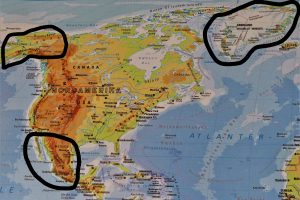
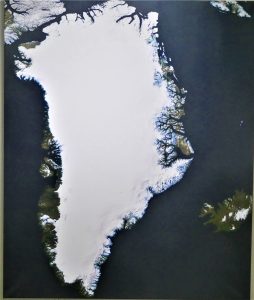
The only places where people can live, year-round, are on the rocky coastal fringes.
As you can see from the satellite image (above) these fringes are mostly along the South Western coast, and the picture below shows the difficult terrain for building and settlement. It’s craggy, rocky and “challenging”.
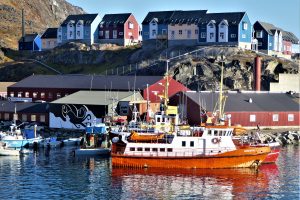
This large country has a tiny population (just under 57.000 people) who live in coastal towns, villages and “settlements” of one sort or another.
41,000 live along the southern third of the western coast (opposite northern Baffin Island, Canada) between Disko Island, Disko Bay and the town of Ilulissat on the north, to the southern tip of the country.
Nuuk, the capital, about half way down that stretch of coast, has almost 18,000 people. The 4 other larger cities/towns, all along the south western coast, have an additional 15,000 inhabitants – 33,000 in total.
There are numerous other smaller settlements scattered along the south west coast (including some north of Disko Bay), and when one adds those in almost 75% of the country’s population lives in that one quarter of the coast.
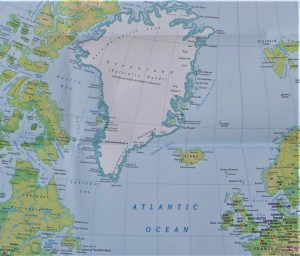
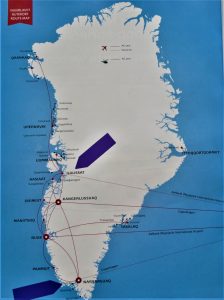
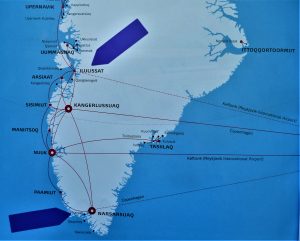
My trip took me between the two arrows on this map – Disko Bay on the North and Narsaq on the south.
There are no roads between any of the cities or towns. Transportation is by boat or air, so “logistics” for the inhabitants, and for visitors, are a significant issue.
I flew, took local ferries and the twice-weekly west coast ferry from Ilulisaat to Narsaq (3 days)
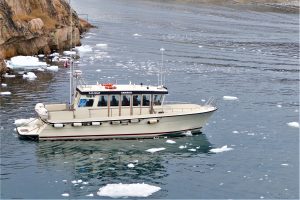
This is a typical local ferry
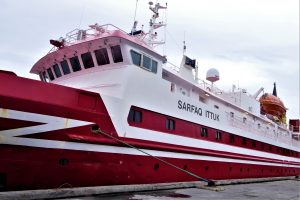
This is the coastal ferry
When, and by whom, was Greenland settled?
Signs of earliest habitation of Greenland date back 4,000 to 5,000 years (curiously in the coldest, nastiest, most inhospitable far north).
These original settlers were Inuit, who crossed the Behring Land Bridge from Siberia to Alaska, and slowly moved eastward, in successive waves, across the harsh climate of northern Canada and eventually to Greenland.
As the waves of Inuits moved eastward, their culture, and particularly their language, changed incrementally, so that, for instance, Eastern Canadian Inuits can speak to the Western Greenland Inuits, but not to the Eastern Greenland Inuits – fascinating!
One of the people I talked to (who had his historic facts pretty straight) said he wasn’t sure if the waves of settlers from the west died out and were replaced by new waves or if they assimilated (or were assimilated by) the new arrivals. Something to speculate about, but for which the answers will require new archeological discoveries in this forbidding climate.
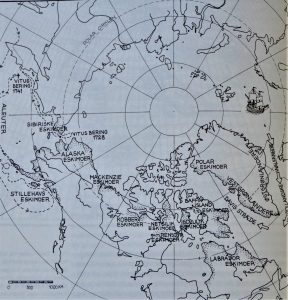
This map shows the eastward expansion (from the Behring Ice bridge to Greenland) of the Inuit people.
The map is old, and uses the term “Eskimoer”, which has been replaced by Inuit.
Settlement by the Norwegians (also known as “Norse” and “Vikings”)
Iceland was settled before Greenland, and the Icelandic Age of Settlement is considered to have lasted from 874 to 930, at which point most of the uninhabited island had been claimed by new arrivals, seeking a “better life” (sound familiar)?
Erik the Red, an Icelandic Norwegian, discovered Greenland, and, according to the Icelandic Saga’s “In the summer [of 982], Erik left to settle in the country he had found, which he called Greenland, as he said people would be attracted there if it had a favorable name.”
Erik originally landed in southwest Greenland; near Narsaq; an area I visited and saw some Norse ruins, dating from the time of Erik – around 1,000 and later – around 1,300.
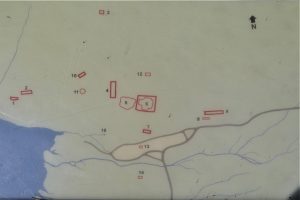
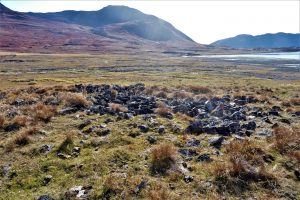
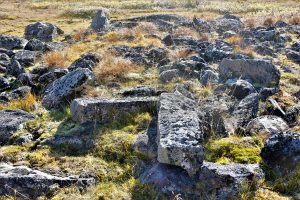
According to National Geographic “Sheep and potato farms still flourish in that same southwestern corner of Greenland, which sits at a more southerly latitude than neighboring Iceland”.
This picture could be in Montana or Colorado, except for the icebergs.

Today’s Greenlanders call their country Kalaallit Nunaat, which simply means “Land of the People” in the Greenlandic Inuit language.
On going settlement and exploration
There were up’s and down’s in the Norse population in the southern part of Greenland.
A “mini ice age” caused many to abandon their settlement efforts, and one “story” is that they tried to stay with their historic practices and didn’t adapt to the (successful) survival tactics of the Inuit.
PART 2, coming soon,
will include my adventure on the Ice Sheet (a short trek and an overnight camp-out) and the magnificent glaciers and icebergs in and around the Ilulissat Icefjord in Disko Bay; Greenland’s first-ever UNESCO World Heritage Site (2004); a 61-km long fjord packed full of unimaginably large icebergs that have calved from its feeder glacier, Sermeq Kujalleq, and some unexpectedly beautiful mountains.
TEASER PICTURES

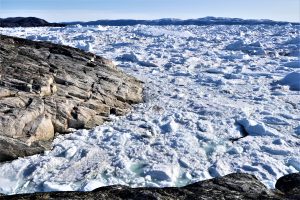
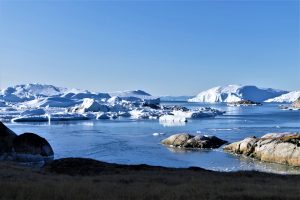
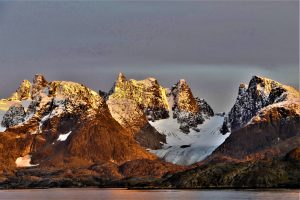
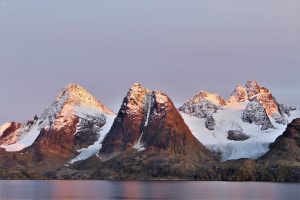
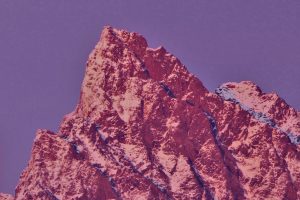
STAY TUNED
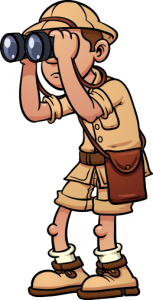
Looks like an amazing trip so far. Looking forward to part 2!
Thanks, Kraig – glad you liked it – working on part 2
Thank you, Adrienne, for your kind and thoughtful comments. It’s a pleasure for me to share my experiences with my friends (and to have a real-time record to refer back to). All the best. George
Amazing landscape and great information..thanks for sharing..George the Explorer!
Thanks, Swosti. Looks as if you all are enjoying the family time
Wow George!
Great photos and super interesting writing.
So I guess I better add it to our list of places we need to explore.
Thanks for writing these stories.
Jim
Thanks, Jim – use local boats!